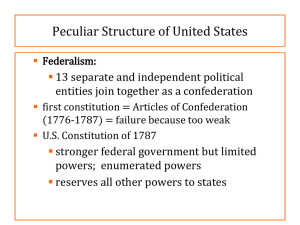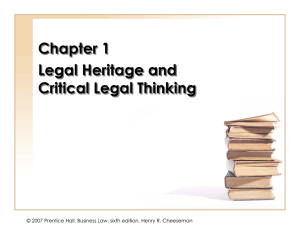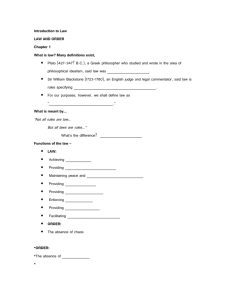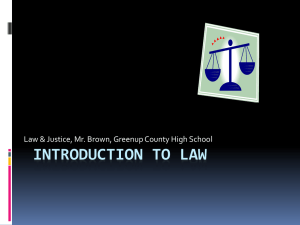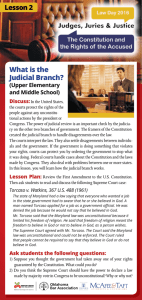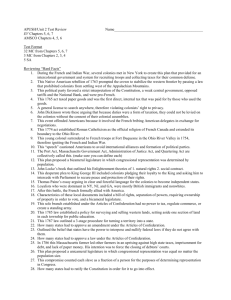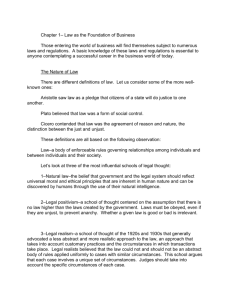RO 1
advertisement
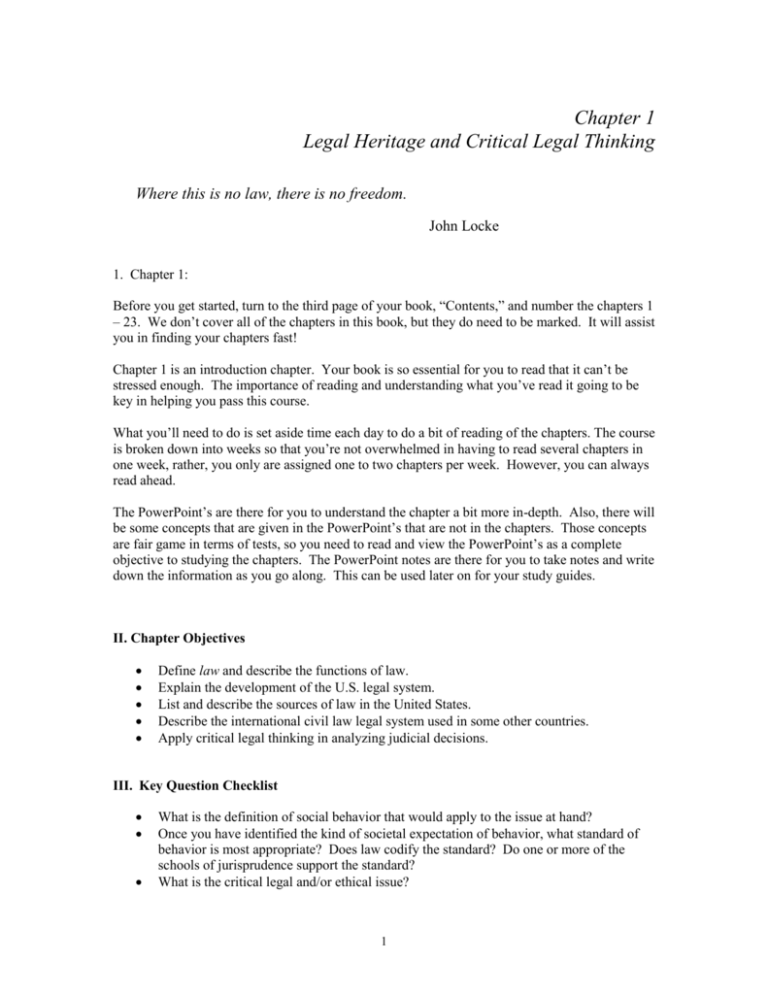
Chapter 1 Legal Heritage and Critical Legal Thinking Where this is no law, there is no freedom. John Locke 1. Chapter 1: Before you get started, turn to the third page of your book, “Contents,” and number the chapters 1 – 23. We don’t cover all of the chapters in this book, but they do need to be marked. It will assist you in finding your chapters fast! Chapter 1 is an introduction chapter. Your book is so essential for you to read that it can’t be stressed enough. The importance of reading and understanding what you’ve read it going to be key in helping you pass this course. What you’ll need to do is set aside time each day to do a bit of reading of the chapters. The course is broken down into weeks so that you’re not overwhelmed in having to read several chapters in one week, rather, you only are assigned one to two chapters per week. However, you can always read ahead. The PowerPoint’s are there for you to understand the chapter a bit more in-depth. Also, there will be some concepts that are given in the PowerPoint’s that are not in the chapters. Those concepts are fair game in terms of tests, so you need to read and view the PowerPoint’s as a complete objective to studying the chapters. The PowerPoint notes are there for you to take notes and write down the information as you go along. This can be used later on for your study guides. II. Chapter Objectives Define law and describe the functions of law. Explain the development of the U.S. legal system. List and describe the sources of law in the United States. Describe the international civil law legal system used in some other countries. Apply critical legal thinking in analyzing judicial decisions. III. Key Question Checklist What is the definition of social behavior that would apply to the issue at hand? Once you have identified the kind of societal expectation of behavior, what standard of behavior is most appropriate? Does law codify the standard? Do one or more of the schools of jurisprudence support the standard? What is the critical legal and/or ethical issue? 1 Chapter 1 What body of law and/or ethical standards apply? How would you apply these standards to the facts? IV. Text Materials Section 1: What Is Law? This first chapter serves as an introduction to the historical underpinnings of jurisprudential thought, tracing the development of law in the United States from its roots in English common law, and acknowledges the influences of both French and Spanish civil law. The Internet & Online Commerce: Students Plug into the Internet and the Law This box discusses how the Internet has revolutionized campus life. Over 90 percent of college students own personal computers. Traditional libraries have become obsolete for many students as many students conduct almost all of their research online. Definition of Law – A body of rules of conduct that must be obeyed; violators will be subject to sanctions or legal consequences. Functions of the Law – Laws exist to keep peace, shape moral standards, promote social justice, maintain the status quo, facilitate orderly change and planning, provide a basis for compromise, and to maximize individual freedom. Fairness of Law – The United States legal system is one of the most fair and comprehensive in the world today. Flexibility of the Law – The United States legal system is dynamic, changing along with societal, technical, and economic norms. Landmark Law: Brown v. Board of Education This box discusses the application of law where the Supreme Court overturned the “separate but equal” doctrine that condoned separate schools for black children and white children. Section 2: Schools of Jurisprudential Thought The Natural Law School emphasizes a moral theory of law; examples include the U.S. Constitution, the Magna Carta, and The U.N. Charter. The Historical School believes that changes in societal norms will be reflected in the law, whilst the Analytical School emphasizes the application of logic to the facts in each case. The Sociological School proponents are realists, believing that laws are a tool to shape social behavior and looking upon precedence with disfavor. The Command School believes that, rather than being a reflection of current social norms, laws are enforced by the ruling party to maintain their power structure. More recently, we have seen the development of the Critical legal Studies School, which views laws as a barrier used by the powerful to maintain the status quo, rather than applying arbitrary rules of what is fair, and the Law and Economics School, which promotes market efficiency as the central goal of legal decisions. Section 3: History of American Law English Common Law – The basis behind English common law is that of judges’ decisions serving as precedent for later decisions. 2 Legal Heritage and Critical Legal Thinking Prior to 1066, each locality in the British Isles was subject to the law of the lord or chieftain that held control of the area. When William the Conqueror took control of Britain, he started replacing the diverse number of laws with a uniform system, rewarding his followers by making them judges in his law courts. These courts emphasized form over procedure, often resulting in unfair results since the courts only issued monetary judgments. To remedy this, chancery, or equity, courts were established. The Court of Chancery issued equitable remedies that were shaped to fir the particular situation. Merchant Courts evolved during the Middle Ages to deal with the peculiarities of commercial disputes. All states except Louisiana have legal systems based primarily upon the English common law system. Contrast this system with the Romano-German civil law system, which dates to 450 B.C., with the Roman adoption of the Twelve Tables, and the later Napoleonic Code of France and the German Civil Code. In the United States and Great Britain, laws are created by both the legislatures and the judiciary, whereas the Civil code, followed by many European countries, comes solely from statutes. Section 4: Sources of Law in the United States The Constitution of the United States is the supreme law of the land and any other law that conflicts with it is unconstitutional. The Constitution established three branches of government: the legislative, the executive, and the judicial. Any power not specifically reserved to the federal government is reserved for the states, all of which have their own constitutions, usually patterned after that of the U.S. Treaties – The President, upon the advice and consent of the Senate may enter into treaties with foreign governments. Codified Laws – Statutes are written laws that are enacted by the legislative branch of both the U.S. and its states. State legislatures often delegate lawmaking authority to local governmental bodies who adopt ordinances. Executive Orders – Both the president and state governors, through both express delegation from the executive branch and implied power from the U.S. and state constitutions, may issue executive orders. Regulations and Order of Administrative Agencies – The legislative and executive branches may create administrative agencies that are empowered to interpret and enforce statutes passed by the legislatures. The decisions of these administrative branches are called orders. Contemporary Trend: Department of Homeland Security The Department of Homeland Security placed 22 federal agencies, ranging from the Bureau of Customs and Border Security to FEMA, under a single umbrella in order to reduce the U.S.’s vulnerability to terrorist attacks. Judicial Decisions – Courts issue judicial decisions which usually include the legal reasoning used to decide the cases. Constitutional principles are given living meaning through the critical legal thinking process of using stare decisis on a case-by-case basis. This adherence to precedent promotes uniformity of law, making it more predictable and stable. Priority of Law in the United States – The U.S. Constitution and treaties take precedence over all other laws. Statutes take precedence over regulations, valid federal laws take precedence over conflicting state laws, which, in turn, take precedence over municipal ordinances. Section 5: Critical Legal Thinking Judges specify the issues in each case, identify key facts, and apply law to reach a conclusion, a process known as critical legal thinking. 3 Chapter 1 Key terms – The plaintiff brings the original lawsuit against the defendant. The party who appeals a decision of a lower court is called the petitioner or appellant; the respondent or appellee must answer the petitioner’s appeal. Briefing a Case – Students sometimes find it useful to “brief” a case in order to clarify the legal issues and the reasons for the court’s determinations. Element of a Case Brief – The most common parts of a brief include the case name along with the citation and court, a summary of the key facts, the issues, the judge’s holding, and a summary of the court’s reasoning in the form of an opinion. V. Terms case brief—A summary of each of the following items of a case: case name and citation, key facts, issue presented, holding of the court, court’s reasoning common law—Developed by judges who issued their opinions when deciding a case. The principles announced in these cases became precedent for later judges deciding similar cases. Constitution of the United States of America—The supreme law of the United States. court of chancery—Court that granted relief based on fairness. Also called equity court. critical legal thinking—The process of specifying the issue presented by a case, identifying the key facts in the case and applicable law, and then applying the law to the facts to come to a conclusion that answers the issue presented. executive order—An order issued by a member of the executive branch of the government. judicial decision—A decision about an individual lawsuit issued by federal and state courts. jurisprudence—The philosophy or science of law. law court—A court that developed and administered a uniform set of laws decreed by the kings and queens after William the Conqueror; legal procedure was emphasized over merits at this time. law—That which must be obeyed and followed by citizens subject to sanctions or legal consequences; a body of rules of action or conduct prescribed by controlling authority, and having binding legal force. merchant court—The separate set of courts established to administer the “law of merchants.” ordinances—Laws enacted by local government bodies such as cities and municipalities, counties, school districts, and water districts. precedent—A rule of law established in a court decision. Lower courts must follow the precedent established by higher courts. stare decisis—Latin: “to stand by the decision.” Adherence to precedent. statute—Written law enacted by the legislative branch of the federal and state governments that establishes certain courses of conduct that must be adhered to be covered parties. treaty—A compact made between two or more nations. 4
